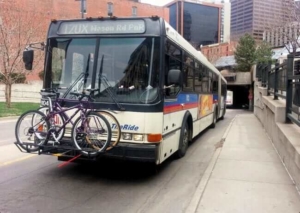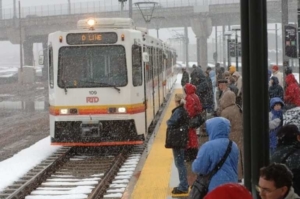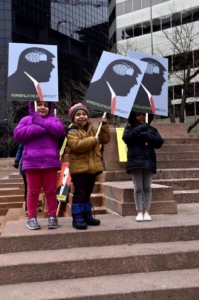 A través de experiencias que van desde un voluntario del Cuerpo de Paz en África Occidental hasta un educador, un abogado practicante, un corredor de ultra distancia, un profesional de mercadotecnia y un empresario, Peter ha forjado una perspectiva única y un carcaj de herramientas potentes para hacer avanzar el negocio de sus clientes. , reputación, imagen y rentabilidad.
A través de experiencias que van desde un voluntario del Cuerpo de Paz en África Occidental hasta un educador, un abogado practicante, un corredor de ultra distancia, un profesional de mercadotecnia y un empresario, Peter ha forjado una perspectiva única y un carcaj de herramientas potentes para hacer avanzar el negocio de sus clientes. , reputación, imagen y rentabilidad.
Conservation Colorado and Western Resource Advocates released the following statements today, praising the Colorado House of Representatives for passing HB18-1069 on a vote of 47 to 14. The bill expands the use of reclaimed water for toilet flushing; it will now move to the Senate for further debate.
“Colorado faces a future where our demand for water will outgrow our supply. That’s why we need to implement innovative policies like this bill, which will stretch our current water resources,” said Kristin Green, Water Advocate, Conservation Colorado. “The future of Colorado’s communities, environment, and economy depends on healthy rivers. This forward-thinking solution is one way to help provide all Coloradans with the water they need while also preserving our precious waterways.”
“Water is the lifeblood of our region, and we need to implement proven solutions that safely and cost-effectively reuse existing water resources. A growing number of states, including, Florida, Washington, Oregon, and Idaho, have already successfully supplemented their water supplies with recycled water,” said Laura Belanger, Water Resources and Environmental Engineer, Western Resource Advocates. “Water reuse, in concert with other water-smart tools and strategies, can help us provide for our communities while also protecting our beloved rivers and lakes.”
This legislation is related to three other bills moving through the Colorado legislature to allow reclaimed water to be used for edible crops and community gardens, marijuana cultivation, and industrial hemp use. HB18-1069 now moves on to the Colorado Senate for consideration.
Written by Audrey Wheeler
Colorado’s population is growing. How can we support our increasing population with transportation systems that work?
As anyone who’s been stuck in traffic recently can tell you, Colorado has a transportation problem. Our roads are deteriorating, our highways are overcrowded, and our public transit options have frustrating limitations.
The big reason why we have these problems is that our population has been growing, increasing the demand on our transportation systems while funding for roads and public transit has remained stagnant.
The gas tax, which pays for our roads, has not been increased since 1991 and doesn’t rise with inflation. Colorado is ranked 29th among states in per capita funding for public transit. On average, states cover 24 percent of the costs of operating public transit; Colorado provides only 1 percent. The Colorado Department of Transportation (CDOT) estimates that we need $9 billion just to boost our transportation network to a level adequate to meet the needs of our state right now.
It’s no wonder our leaders — like Speaker of the House Crisanta Duran, Senate President Kevin Grantham, and Governor John Hickenlooper — agree that transportation funding is a top priority. Coloradans should have the freedom to get to where they need to go, and our state government has a responsibility to address these problems.

So why haven’t we agreed on a solution? Last year, a few decided the fate of many. In 2017, a bipartisan state bill (House Bill 1242) would have proposed a tax increase to voters to fund highways, local infrastructure projects, and bike, pedestrian, and transit options. Even this thoughtful, bipartisan effort that would have needed voter approval on the ballot did not make it out of the legislature. It was killed by a select group of Senate Republicans (read: The New “Kill” Committee).
This legislative session, we’ve seen ill-fated efforts at bonding measures to fix our transportation problems, but none have been the solution we need.
For a transportation solution to truly solve our problems, it must:
- Be statewide and flexible. We want a system that provides funding to the whole state, addressing a full array of needs and creating flexible local funds.
- Have a new, sustainable funding source. The general fund in Colorado alone cannot meet this need. While there may be some patches or band-aid solutions from the legislature, we will ultimately need an updated funding source. It’s worth repeating: CDOT estimates we need $9 billion just meet the transportation needs of our state right now.
- Dedicate significant dollars to multi-modal (non-car) options. We need a system that works for all people, and that means all modes of getting around. This might mean funding for transit districts, sidewalks, shuttles for people who are disabled or elderly, rapid bus transit on highway corridors, and more. The system needs to move people, not just cars.
Time and again, the debate comes down to these problems. This year’s funding proposal is an irresponsible attempt to address this serious problem. It fails to meet criteria #2 and #3 above, prompting us to ask two questions:
Where’s the money coming from?
 Some people seem to think the funding solution is easy and straightforward, that using existing resources to bond for transportation. But taking a bond (or loan) against our already narrow budget is not free money. Locking hundreds of millions of dollars into bonding without creating a new revenue source merely shifts the problem down the road to future generations. If Colorado is stuck making bond payments during another recession, we would need to cut other critical areas from the budget, which could mean less money for things like schools or health care. The general fund cannot be the only source of funding. Solutions for transportation can include bonding, but it should be done responsibly, with a new source of revenue to pay for it and in a way that does not mortgage our future.
Some people seem to think the funding solution is easy and straightforward, that using existing resources to bond for transportation. But taking a bond (or loan) against our already narrow budget is not free money. Locking hundreds of millions of dollars into bonding without creating a new revenue source merely shifts the problem down the road to future generations. If Colorado is stuck making bond payments during another recession, we would need to cut other critical areas from the budget, which could mean less money for things like schools or health care. The general fund cannot be the only source of funding. Solutions for transportation can include bonding, but it should be done responsibly, with a new source of revenue to pay for it and in a way that does not mortgage our future.
How is it addressing our long-term needs?
We can’t have a transportation solution that doesn’t include funding for transit, bikes, and pedestrians. There are three reasons why:
First of all, transportation is a climate issue. The transportation sector is now the leading contributor to greenhouse gas emissions nationally, surpassing the energy sector. In order to fight climate change, we must change the way we move.
Second, we need to boost transportation options if we want to get serious about reducing traffic. Widening highways doesn’t reduce congestion. When we add lanes to a highway, there is a short time during which congestion does drop – but studies show that within a few years, traffic is as bad as it was before the road was widened. Instead of focusing on highways alone, we need to focus on mobility, and providing different options for moving people — not just cars — is the best way to do that.
 Third, we need transportation options because they are good for our economy, public health, and safety. Increasing walkability and bike-ability of neighborhoods boosts property values and increases revenues for local businesses. People who use public transit take 30 percent more steps per day than people who drive, meaning that more transportation options can improve public health in more ways than one. Transportation is one of the largest sources of air pollution, which is especially important in places like Colorado’s Front Range that suffer from ozone pollution and smog. Breathing ozone can trigger a variety of health problems, particularly for children, the elderly, and people of all ages who have lung diseases such as asthma.
Third, we need transportation options because they are good for our economy, public health, and safety. Increasing walkability and bike-ability of neighborhoods boosts property values and increases revenues for local businesses. People who use public transit take 30 percent more steps per day than people who drive, meaning that more transportation options can improve public health in more ways than one. Transportation is one of the largest sources of air pollution, which is especially important in places like Colorado’s Front Range that suffer from ozone pollution and smog. Breathing ozone can trigger a variety of health problems, particularly for children, the elderly, and people of all ages who have lung diseases such as asthma.
We can’t keep arguing in circles about how to fund transportation. We need to agree on a new funding source that will prioritize flexible, statewide funding and invest in transit, bike, and pedestrian options as well as highways and roads.
Only then will we be sure that the Colorado of the future is a great place to live.
Written by Audrey Wheeler
Colorado’s Senator Cory Gardner has claimed many times that he values our outdoors and environment. Unfortunately, when it comes to conservation and environmental issues, Senator Gardner has little to brag about. In fact, Gardner has voted with President Trump 92.4 percent of the time since Trump took office, both on environmental issues and everything else that’s come up in the Senate.According to the League of Conservation Voters’ 2017 National Environmental Scorecard, Sen. Gardner received a zero percent score. According to the 19 Senate votes scored, Gardner could not have been a worse ally for the environment. Let’s take a look at some of his votes.
1. For Scott Pruitt to lead the Environmental Protection Agency.

Protesters outside of Gardner’s Denver office raise the cry against Scott Pruitt.
In spite of hundreds of calls to his office, protests outside of his office, and social media campaigns, Gardner supported Scott Pruitt. Pruitt has denied man-made climate change and is known for his many lawsuits against the EPA. Now he is the head of the agency.
2. For Rick Perry to be the Secretary of Energy.
Perry’s famous slip where he forgot the Department of Energy was one of the agencies he wanted to eliminate is not even his biggest disqualifier for being Secretary of Energy. He has ignored the consensus around climate science and has many financial ties to energy companies, yet Congress — and Sen. Gardner — approved him for the position.
3. For Rex Tillerson, the CEO of Exxon Mobil, to be Secretary of State.
Tillerson led Exxon during its long-term campaign to spread lies about climate science and deceive the public. He also has deep ties to Russia and Putin, which should have disqualified him from representing our country on the international stage. Instead, Congress voted to confirm him.
4. For Ryan Zinke to be Secretary of the Interior.
At first, Zinke seemed like the least extreme member of Trump’s cabinet. However, his financial backing from the oil and gas industry makes him less than suitable to manage our public lands. His record since becoming Secretary of the Interior has been peppered with misuse of funds and efforts to undermine public land protections, like shrinking Bears Ears and Grand Staircase-Escalante National Monuments in Utah.
5. To undo a rule that would have made it easier for the public to influence decisions about our public lands.
The Bureau of Land Management (BLM) had recently made a rule to update land management processes. Both experts and the public agreed it was a much-needed step to improving management of our public lands. Senator Gardner’s vote overturned this rule and prevented the BLM from ever making a similar rule. This is an example of shutting out local voices while putting our public lands at risk.
6. His vote to repeal the stream protection rule allows coal companies to have a freer hand in dumping mining debris in streams.
This debris pollutes streams with toxic heavy metals, which can have dire health impacts on the communities nearby. It was yet another move to stand up for fossil fuel companies at the expense of our health and people.
7. To move forward with repealing a rule that protects our air from oil and gas emissions.
 Methane, a potent greenhouse gas, leaks from oil and gas sites across the country, wasting taxpayer dollars and exacerbating climate change. The Bureau of Land Management’s Methane Rule established commonsense standards that require oil and gas companies to deploy readily available, cost-effective measures to reduce methane lost through venting, flaring, and leaks. While the rule itself is still in question, there’s no doubt that Sen. Gardner went against the wishes of most Coloradans and voted to repeal the rule.
Methane, a potent greenhouse gas, leaks from oil and gas sites across the country, wasting taxpayer dollars and exacerbating climate change. The Bureau of Land Management’s Methane Rule established commonsense standards that require oil and gas companies to deploy readily available, cost-effective measures to reduce methane lost through venting, flaring, and leaks. While the rule itself is still in question, there’s no doubt that Sen. Gardner went against the wishes of most Coloradans and voted to repeal the rule.
9. To open the Arctic National Wildlife Refuge to drilling.
This vote was snuck into the Tax Bill that Congress passed in December 2017. There was a proposed amendment to remove the piece of the Tax Bill that allowed for drilling in the Arctic Refuge — but Sen. Gardner voted against the amendment, and voted to pass the Tax Bill. Now the largest protected wilderness in the country, known to the indigenous Gwich’in people as “the sacred place where life begins,” is open to drilling.
In an increasingly blue state which Gardner won by a slim margin in 2014, he’s becoming one of the country’s least-liked politicians. Not only did Coloradans vote decisively for Hillary Clinton, but they care about the issues Gardner has attacked. The environment is a key example.
During his 2014 campaign, Gardner repeatedly claimed to be “Not That Kind Of Republican”. In order to win Colorado, he tried to separate himself from the extreme partisanship and positioning of his party. He advocated for clean energy and protecting future generations.
Cory Gardner’s 2014 campaign video was all about the environment.
“What can we do to make sure we are protecting this beautiful environment?” he asked on the campaign trail. However, Senator Gardner’s promises to be a “new kind of Republican” have proved to be empty.
On environmental issues, Gardner’s track record leaves much to be desired. Despite his efforts to portray himself as a Westerner who values public lands and protecting our future, his voting record tells the truth.
At the same time, Gardner still claims to love the environment. In February, he and Senator Bennet introduced a package of public lands bills designed to fix a couple of tiny issues with Colorado’s public lands. These bills would affect a grand total of less than 1,000 acres of public lands — out of 24 million acres in Colorado. Although Gardner says he’s “proud” to work on bills like this “that will ensure future generations of Coloradans are able to enjoy our state’s natural treasures,” these bills are a distraction from his anti-environmental onslaught.
We must continue to tell Senator Gardner that Coloradans don’t want to see him siding with Trump. Especially when it comes to our air, land, and water, which he campaigned for and claims to support, Gardner needs to vote with his constituents.



